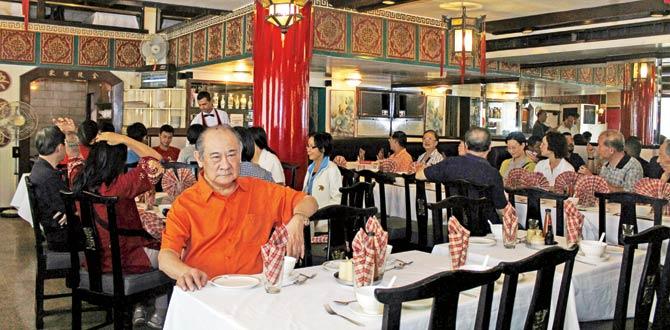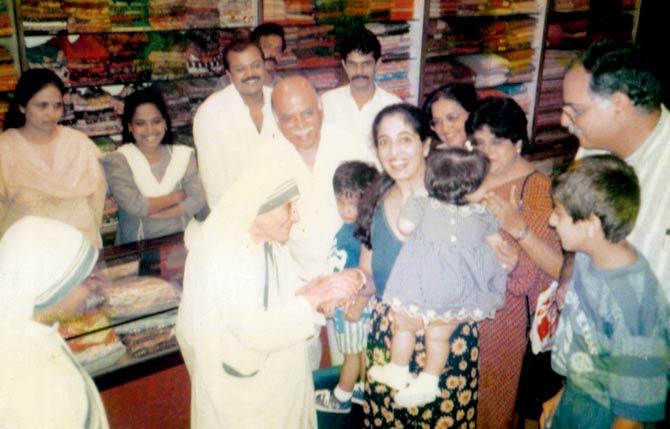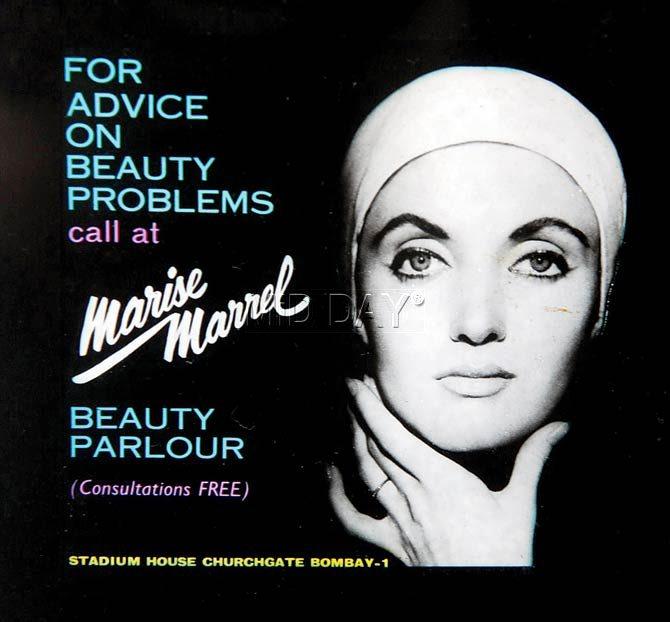Just how much of the roaring romance of its heyday does the west half of Veer Nariman Road at Churchgate retain?


Tulun Terence Chen, one of the partners of Kamling, got the restaurant as an act of appreciation from an elderly Chinese gentleman he helped in an accident at Ballard Pier as an 18-year-old. Pic/Poonam Bathija
ADVERTISEMENT
 It isn’t often that a short stretch of street stands out for three well remembered rites of passage. Veer Nariman Road is something like that for me.
It isn’t often that a short stretch of street stands out for three well remembered rites of passage. Veer Nariman Road is something like that for me.
First, the wedding trousseau search led to Kaysons for a cocktail sari — marrying a man who worked in a suit weeklong meant formal dos would be de rigueur. Next, we were at Bryan Adams’ concert on the Brabourne grounds, me pregnant and desperate to use a loo — dashing across to Ambassador Hotel, we both pointed to my tummy so exaggeratedly, an alarmed darban swiftly waved us into their washroom. Finally, baby arrived, needing tiny muslin jhabla vests over nappies — K Rustom it was for this and, as he grew, ice cream sandwich treats. Khodabux Rustom’s store from 1938 closed in the 1990s, but is survived by the ice cream service introduced in 1953.

Mother Teresa on her visit to Kaysons in 1995
Why is this particular strip of Veer Nariman Road distinctive? Churchgate Station to Marine Drive, not a single of its 1930s Art Deco landmarks has been demolished. Once simply Churchgate Road, its newer name is a nod to nationalist lawyer Khurshed Framji Nariman who suggested the Arabian Sea waters be reclaimed for a commercial hub. That precinct, Nariman Point, got this street buzzing a lot busier.

The “Marise Marrel face” became the beauty icon of the 1960s and ’70s; the still standing salon’s clientele then included Nargis Dutt and Persis Khambatta. Pic/Datta Kumbhar
Vikram Kamdar, managing director of Kamdar Furniture, has the earliest showroom at Industrial Assurance Building (now LIC) Building from 1940. He says, “Unlike today’s government monstrosity, the station used to be a cute gabled roof structure, its entrance displaying a large Capstan cigarette ad.” His recent neighbour, Air Cool Hairdressers, retains the classic 1957 feel of an original location outside the station. It belongs to one of the families owning Asiatic, the department store of the Shahs, Guptas and Kamats since 1977. On the east flank, Beryl salon made way for Middle East Airways and then Lakme moved in.
“Lakme had the prettiest white chairs and curtains,” says Dhun Khandalavala. The widow of theatre producer Pesi Khandalavala recalls her father-in-law ride a Victoria to work at Bank of Tokyo beyond Flora Fountain, at the end of the road immortalised by St Thomas’ Cathedral and Akbarally’s. Her front room boomed with laughter from a flurry of 1960s revue rehearsals. Adi Marzban directed singing stars like Jimmy Pocha and his wife Uma (think “Bombay meri hai”). From their third floor balcony the Khandalavalas recognised regulars at Bombelli’s, admen sipping cappuccinos primed to perfection by Swiss proprietor Freddie. Yards away, at The Ambassador, the flamboyant Greek, Jack Voyantzis, hosted The Tony Pinto Quartet at The Other Room on black tie nights — thick Havana in one hand, slim woman on the other.
The 1940s street sizzled with jazz joints. Napoli bistro boasted Bombay’s first jukebox, pulling in jaunty kids from nearby colleges. Past the neglected Tea Centre at Resham Bhavan, Berry’s was serenaded by the Dorothy Jones Quartet. And, everyone who was anyone was at Gaylord — currently celebrating its 60th anniversary — to watch India’s only jazz violinist Ken Cumine’s wild wizardry on strings, his daughter Sweet Lorraine on the mike. With chintzy decor and liveried stewards, establishments like Emile Gourdon’s faded in sad farewell to smoky-toned ensembles whose routines rocked this road purring with Packards, Buicks and Studebakers. Those jumping, jiving crowds electrified the same stretch over which a dull evening air descends today, especially after office-goers catch homebound train seats.
In that age of amicability, low hedges planted between cafes ensured everyone remained within handshake reach. “It was never rivalry, we complemented each other — restaurants need an eco system too,” says Deepak Purohit of book-themed Mockingbird Cafe. His grandfather opened Purohit’s at this spot in 1939. Running away from Keshod village of Saurashtra, Harjivandas Purohit found himself a farsan counter job at VT. Lured by the Parekh Mahal landlord’s offer of free fans, he shifted to Churchgate, serving thalis at 3 annas! Harjivandas died when Deepak’s father Krishnakant was just 5, leaving his unlettered wife Vijayagauri to take over. She did, with determined pluck, even introducing 1 kilo silver thalis from the 1940s. The Jamsaheb of Jamnagar patronised Purohit’s for Brahmin cooks stirring up a storm of shudh shakahari in the kitchen. Their thali-wowed music celebrities include Boy George, the Rolling Stones and Michael Jackson’s band.
Other shuttered icons are Ferry Restaurant, Chopsticks and Pearl of the Orient — Ambassador’s revolving restaurant which provided a 360-degree panorama of Bombay in a 90-minute axis rotation. Across at Soona Mahal, Parisian Dairy mixed the frothiest milkshakes and crumble-in-mouth mawa cakes till the Narangs morphed this plot from Talk of the Town into Jazz by the Bay, into Pizza by the Bay. Soona Mahal’s pride is Nana Chudasama’s topical banner. Fluttering brave in the breeze, it has seen sunsets from this vantage point over 45 years. At Maneck Mahal opposite, The Garden Silk Mills office replaced Swissair’s premises in 1984. Its advertising director Shilpa Shah views these eateries as epitomising the city’s plural culture — “Diehard vegetarians and hard-core non-veggies have a place to go, every pocket size accommodated, one-star Irani to four-star diners.”
Like Purohit, Kamling started in 1939. How 70-year-old Tulun Chen came to possess this restaurant with a menu of 400 Cantonese and Hunan dishes is a story warmer than the soup bowls steaming his tables. Cut to when Chen was 18. After watching The Guns of Navarone at Ballard Pier’s Rex Cinema with friends, he saw an elderly Chinese man knocked down by a cab. The boys admitted him to hospital. When he recovered, they realised the accident victim KC Tham was from Hong Kong. Pooling money with more people, they paid his 3,000-rupee sea passage back. As he sailed off, the gent pressed a piece of paper into Chen’s hand, saying “This is yours.” Gratitude for the kindness of strangers — it was the deed to Kamling.
For a break from Restaurant Row, I pop in at Marise Marrel. The vibe relaxing, the music energising, my head soon swirls with calming scents. Soothed by the Zen haze the 62-year-old salon de beaute exudes, I also learn a little social history from Meher Mehta. Her mother Khorshed partnered Frenchwoman Marise who ran the business with a shrewd head. Flashed in movie halls, the publicity campaign modelled the haunting “Marise Marrel face”. Letters from a Who’s Who of 1960s and ’70s stunners show who led Bombay’s swish trends. Actress Nargis Dutt drove up in her Impala from Chateau Marine round the corner to enjoy facials and steam baths. As would fashion mavens Persis Khambatta and Shai.
A hop from the salon, another old-time Stadium House tenant proves stylish enough to have had Maharani Gayatri Devi pick printed chiffons from a treasure trove of saris. Kaysons devotees include Kiron Kher and Asha Bhonsle, known for exquisite selections of such six-metred elegance. Warned their shop could suffer on a road lined with airline offices and cafes, the Jashnani brothers from Lucknow nurse no regrets. Mother Teresa was a memorable visitor here. “I got a call humbly requesting our defective saris be donated to her missionaries,” Gulu Jashnani recollects. “They were getting a group of girls married. Naturally, we didn’t give damaged saris.”
My last halt is Indian Merchants’ Chamber, which floats instantly within sight of thousands of commuters disgorging daily from the station terminus. Famously housing Stadium Restaurant and the Western India Automobile Association, its FE Dinshaw Commercial and Financial Reference Library is packed with remarkable picture archives. Rare photographs of charismatic freedom fighters, pioneers and entrepreneurs explain IMC’s place at the helm of the country’s trade and industry. Its director general, Arvind Pradhan, says, “As the finest manufacturers of textiles we needed a forum for our voice instead of white men’s clubs.” Underscoring Swadeshi hope, IMC was set up in 1907 on Esplanade Road, Fort.
Mahatma Gandhi has been honoured as its sole Honorary Member in 1933. Inaugurating the present headquarters in 1939, Vallabhbhai Patel declared: “The founders of the Chamber were enlightened, bold and imaginative.”
The very adjectives, it seems, to describe the visionaries who built a Bombay street to cherish.
Author-publisher Meher Marfatia writes fortnightly on everything that makes her love Mumbai and adore Bombay. You can reach her at mehermarfatia@gmail.com
 Subscribe today by clicking the link and stay updated with the latest news!" Click here!
Subscribe today by clicking the link and stay updated with the latest news!" Click here!






